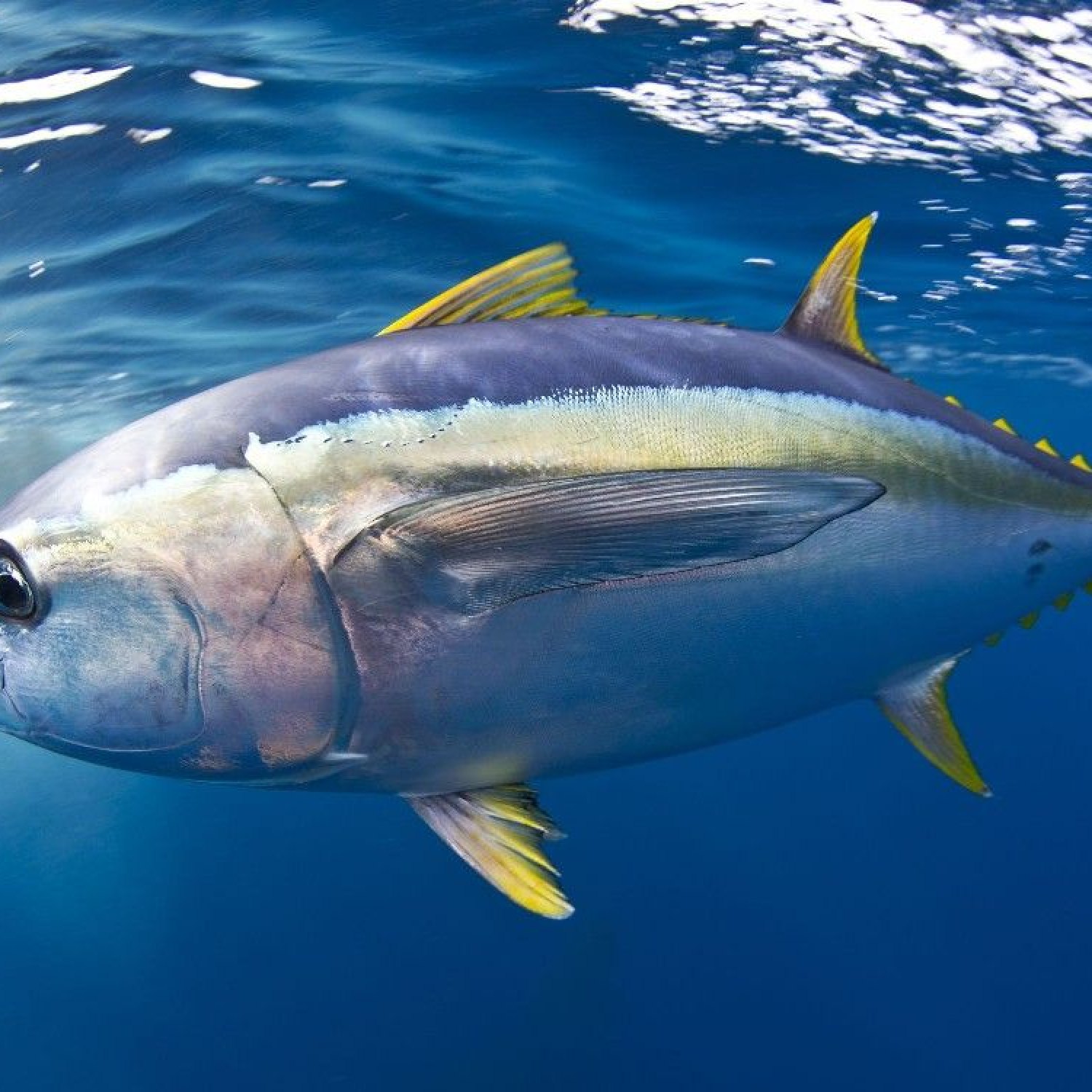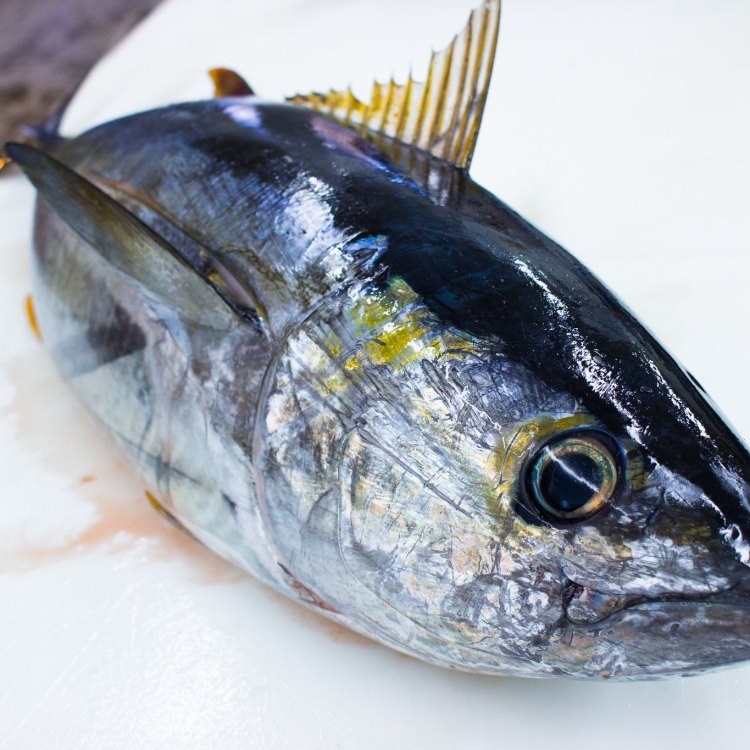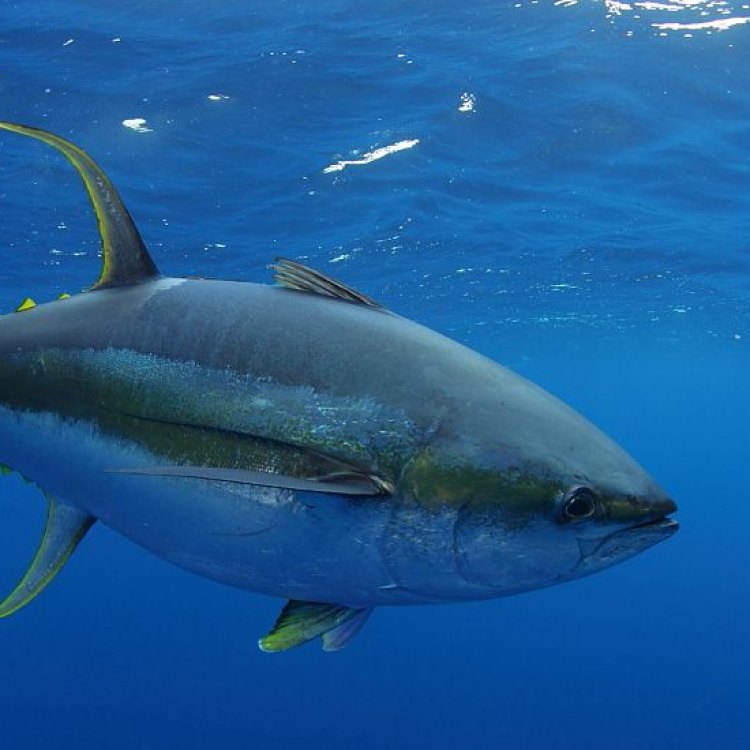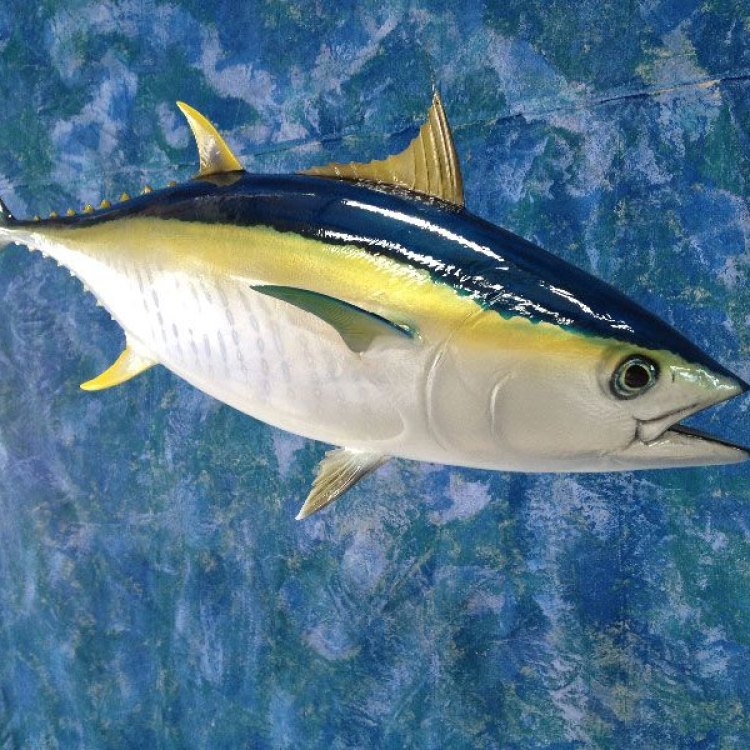
Yellow Fin Tuna
Up to 2.4 meters (7.9 feet)
Yellow Fin Tuna, known for its vibrant color and delicious taste, can grow up to 2.4 meters in length and is found in the open ocean. Belonging to the Scombridae family, their streamlined and torpedo-shaped body allows them to swim at high speeds. These apex predators are highly sought after by humans and play a crucial role in maintaining the balance of marine ecosystems. #YellowFinTuna #OpenOcean #Scombridae #ApexPredator #MarineEcosystem
Animal Details Summary:
Common Name: Yellowfin Tuna
Kingdom: Animalia
Habitat: Marine
The Magnificent Yellowfin Tuna: A Prized Bounty of the Ocean
The ocean is a vast and mysterious place, teeming with an array of exotic and fascinating creatures. Among the many marine species that call the ocean their home, the yellowfin tuna stands out for its striking appearance and impressive characteristics. Known scientifically as Thunnus albacares, this magnificent fish is commonly referred to as the yellowfin tuna due to its distinctively yellow fins. Native to the tropical and subtropical oceans worldwide, the yellowfin tuna is a prized catch for fishermen and a prized sight for marine enthusiasts Yellow Fin Tuna.A Classification Fit for Royalty
Let's start by delving into the scientific classification of the yellowfin tuna. In the animal kingdom, it belongs to the phylum Chordata, a group of animals defined by the presence of a notochord, a flexible rod-like structure that provides support to the body. The yellowfin tuna also belongs to the class of Actinopterygii, a group of fish characterized by their bony rays on their fins. This class is the most diverse and successful class of fish, with over 30,000 species. The order of the yellowfin tuna is Perciformes, which is the largest order of fish containing about 41% of all bony fish species. Lastly, the yellowfin tuna belongs to the family Scombridae, a family of mackerel and tuna-like fish.Where to Find Yellowfin Tuna
If you're an avid angler, you've probably heard of the elusive yellowfin tuna. It is distributed across the tropical and subtropical oceans worldwide, with a vast range of habitats that include the Indian, Pacific, and Atlantic oceans. However, unlike most species, the yellowfin tuna has no distinct country of origin as it is a pelagic species, meaning it spends most of its time in the open ocean Yellow Crazy Ant. This makes the yellowfin tuna a highly migratory species, following currents, and seeking out optimal feeding grounds.A Carnivorous Diet
The yellowfin tuna is at the top of the food chain, and its diet reflects its position. As a carnivorous species, it feeds on a variety of prey, including other fish, squid, and crustaceans. Due to its high energy needs, the yellowfin tuna has become an expert predator, capable of reaching high speeds to catch its prey. This fish's characteristic torpedo-like shape allows it to move through the water with minimal drag, conserving energy while chasing its next meal.Blending In and Standing Out
The yellowfin tuna's most striking feature is undoubtedly its yellow fins contrasting with its blue-black back and upper sides, giving the fish its namesake. This coloration is used for camouflage, making it harder for predators to spot them in the water. The bright yellow fins, which run along the body, also serve as a lure for prey, attracting them with their vibrant colors. This strategic coloration is crucial for the survival of the yellowfin tuna.The Perfect Body for Ocean Life
From its streamlined body to its unique coloration, the yellowfin tuna's entire anatomy is adapted for its life in the ocean. With a lengthy average length of 2.4 meters (7.9 feet), the yellowfin tuna is a powerful and agile swimmer. Its torpedo-like body shape and powerful tail allow it to cruise through the water at remarkable speeds, reaching up to 47 mph (75 km/h). This enables the yellowfin tuna to embark on long-distance migrations and evade predators with ease.A Prized Bounty and a Threatened Species
The yellowfin tuna has been one of the most sought-after fish for centuries, both as a sportfish and a commercial catch. Its delicious, flavorful meat, and high demand in the sushi market have resulted in the overfishing of this species. According to the International Union for Conservation of Nature (IUCN), the yellowfin tuna is currently listed as a near-threatened species with a decreasing population trend. Without proper management and conservation efforts, this magnificent fish could face a rapid decline, leading to significant ecological and economic consequences.The Economic Impact of the Yellowfin Tuna
Apart from being a prized catch for recreational fishermen, the yellowfin tuna also has a substantial economic impact on countries in its range. Its high commercial value has made it a vital source of income for many fishing communities. In the Pacific Ocean alone, the annual catch of yellowfin tuna is estimated to be between 600,000 and 1 million tons, with a global trade value of over US$6 billion. This fish provides employment for millions of people worldwide and plays a crucial role in supporting the economies of many developing nations.The Future of Yellowfin Tuna Conservation
To ensure the survival of the yellowfin tuna and other threatened marine species, governments and international organizations have implemented various measures to manage and conserve their populations. One of these measures is the implementation of catch limits, which sets a maximum amount of fish that can be caught each year, ensuring a sustainable yield for future generations. Additionally, the use of more selective fishing methods, such as pole fishing, has proven to be more environmentally friendly and less destructive to other species.How You Can Help
As consumers, we also have a crucial role to play in the conservation of marine species like the yellowfin tuna. Choosing sustainable seafood options, such as pole and line-caught tuna, can help reduce the demand for unsustainable fishing practices and preserve the diversity of our oceans. We can also support organizations that work towards marine conservation efforts and spread awareness about the importance of sustainable fishing practices.In Conclusion
In the vast expanse of the ocean, the yellowfin tuna stands out for its striking appearance and impressive abilities. Although it faces threats from overfishing, with proper management and conservation efforts, we can ensure the survival of this magnificent fish for future generations. Its role in the ocean and its economic significance highlight the importance of preserving our marine ecosystem. As we continue to explore and understand the natural wonders of the ocean, let us also strive to protect and conserve them.

Yellow Fin Tuna
Animal Details Yellow Fin Tuna - Scientific Name: Thunnus albacares
- Category: Animals Y
- Scientific Name: Thunnus albacares
- Common Name: Yellowfin Tuna
- Kingdom: Animalia
- Phylum: Chordata
- Class: Actinopterygii
- Order: Perciformes
- Family: Scombridae
- Habitat: Marine
- Feeding Method: Carnivorous
- Geographical Distribution: Tropical and subtropical oceans worldwide
- Country of Origin: Not applicable (oceanic species)
- Location: Open ocean
- Animal Coloration: Blue-black on the back and upper sides, yellow on the fins and lower sides
- Body Shape: Streamlined and torpedo-shaped
- Length: Up to 2.4 meters (7.9 feet)

Yellowfin Tuna
- Adult Size: Up to 200 kilograms (440 pounds)
- Average Lifespan: Around 6 to 7 years
- Reproduction: Sexual
- Reproductive Behavior: Spawning
- Sound or Call: No distinct sound or call
- Migration Pattern: Highly migratory
- Social Groups: Schools
- Behavior: Highly active and fast-swimming
- Threats: Overfishing, bycatch, habitat destruction
- Conservation Status: Near Threatened
- Impact on Ecosystem: Important predator in open ocean ecosystems
- Human Use: Commercial and recreational fishing
- Distinctive Features: Long, bright yellow dorsal fin, large eyes, strong and powerful body
- Interesting Facts: Yellowfin Tuna can swim at speeds of up to 75 km/h (47 mph) and are known for their acrobatic leaps out of the water.
- Predator: Sharks, other large predatory fish

Thunnus albacares
The Mighty Yellowfin Tuna: A Marvel of the Ocean
In the vast and mysterious world of the ocean, one creature stands out, both in size and beauty - the magnificent Yellowfin Tuna. With its long, bright yellow dorsal fin, powerful body, and acrobatic movements, the Yellowfin Tuna is a marvel of the sea. But there is more to this remarkable fish than meets the eye. In this article, we will dive deep into the world of the Yellowfin Tuna, exploring its unique features, behavior, and role in our oceans PeaceOfAnimals.Com.A Giant Among Fish
The first thing that captures our attention when we think of the Yellowfin Tuna is its impressive size. Growing up to a whopping 200 kilograms or 440 pounds, this fish is a giant among other fish species. Its average lifespan is around 6 to 7 years, but it can reach up to 10 years in optimal conditions. This means that each Yellowfin Tuna is a veteran of the seas, having survived and thrived in the often harsh and unpredictable ocean.Like most fish, the Yellowfin Tuna reproduces sexually. What makes their reproductive behavior unique is their spawning behavior. Rather than simply releasing eggs into the water, Yellowfin Tuna gather in large groups known as "spawning aggregations" to release their eggs and sperm simultaneously. These aggregations can contain thousands of fish, making it a breathtaking sight for divers and a prime target for commercial fishing.
The Power of Migration
Yellowfin Tuna are highly migratory, traveling great distances throughout their lifetime Yakutian Laika. They swim in schools, usually consisting of individuals of similar size, and follow the ocean currents in search of food and suitable breeding grounds. Their impressive swimming ability allows them to travel long distances, and they have been known to cross entire oceans. This constant movement is essential for their survival and plays a crucial role in their role in the ocean ecosystem.The Social Life of Yellowfin Tuna
Yellowfin Tuna are highly social creatures, and they form schools of hundreds to thousands of individuals. As mentioned before, these schools are made up of individuals of similar sizes, as this allows for efficient swimming and safety in numbers. They have a unique way of communicating with each other, using subtle changes in their movements and positions to convey messages. However, they do not make any distinct sounds or calls, unlike some other marine species.One of the most fascinating things about Yellowfin Tuna is their behavior in the water. Known for their speed and agility, these fish are constantly on the move, darting through the water at incredible speeds of up to 75 km/h or 47 mph. They use their muscular and streamlined bodies to their advantage, swimming effortlessly through the water and making quick turns to capture their prey. Their acrobatic leaps out of the water are a sight to behold and have earned them the nickname "athletes of the sea."
Threats and Conservation Status
Despite their strength and adaptability, Yellowfin Tuna face a number of threats that put their survival at risk. Overfishing, primarily for commercial purposes, is one of the biggest threats to this species. Yellowfin Tuna are a highly sought-after fish for their rich and flavorful meat, making them a valuable commodity in the seafood industry. This, coupled with the high demand for tuna in sushi and other dishes, has led to a sharp decline in their population.Another threat to the Yellowfin Tuna is bycatch, which is the incidental capture of non-target species in fishing nets. This can include other species of tuna, sharks, and other marine animals, leading to significant depletion in their numbers. Habitat destruction, such as the destruction of coral reefs and pollution, also poses a significant threat to the Yellowfin Tuna and their ocean home.
As a result, the International Union for Conservation of Nature (IUCN) has listed the Yellowfin Tuna as "Near Threatened" on their Red List of Threatened Species. This classification means that the species is at high risk of extinction in the wild in the near future if conservation efforts are not put in place.
The Importance of the Yellowfin Tuna in the Ecosystem
The Yellowfin Tuna plays a vital role in our oceans, particularly in open ocean ecosystems. As a strong and powerful predator, they help to keep the populations of other marine animals in check and maintain the balance of the food chain. They also play a significant role in the migration of nutrients through the ocean, as they move from one area to another, they carry valuable nutrients with them, contributing to the health of the ecosystem.Human Use of Yellowfin Tuna
Yellowfin Tuna has been used by humans for centuries as a source of food. In many coastal communities, tuna fishing is a way of life, and it provides a livelihood for thousands of people. Commercial fishing for Yellowfin Tuna has significantly increased in the past few decades, with advanced fishing methods and technology making it easier to capture large numbers of these fish in a short period of time.In addition to its use as a food source, Yellowfin Tuna is also sought after by recreational fishermen. Many anglers find the challenge of catching a Yellowfin Tuna to be both thrilling and rewarding. And with their impressive size, strength, and speed, it's no wonder that they are a popular target for sport fishing.
Distinctive Features and Interesting Facts
Yellowfin Tuna is not just another big fish in the sea; they have many unique features and interesting facts that set them apart from other marine species. Apart from their impressive size and speed, they have large, powerful eyes that help them navigate and hunt in the open ocean. Their long, bright yellow dorsal fin is what gives them their name and makes them stand out among other fish. They also have a strong and muscular body, designed for speed and endurance in the water.Fun fact: Did you know that Yellowfin Tuna can swim at speeds of up to 75 km/h or 47 mph? That's faster than most cars on the road! This, combined with their acrobatic leaps, makes them a sight to behold in the ocean.
Unfortunately, with the decline in their population, sightings of Yellowfin Tuna in the wild have become less frequent. And with their elusive and fast-swimming nature, it's not every day that we get to witness their acrobatic abilities in person. Therefore, it's crucial to protect and conserve these magnificent creatures for future generations to enjoy and appreciate.
The Predator and the Prey
As with any other animal, Yellowfin Tuna also have predators. Sharks and other large predatory fish are the main predators of Yellowfin Tuna. Yet, despite these natural predators and the many human-caused threats, Yellowfin Tuna continues to thrive in the ocean. With their incredible speed, agility, and adaptability, they have shown that they are a resilient species, capable of surviving and thriving in even the most challenging conditions.Peril or Promise?
The Yellowfin Tuna's conservation status may seem bleak, but there is still hope for this species. Many organizations and individuals have recognized the urgent need to protect the Yellowfin Tuna, and efforts are being made to reduce overfishing and regulate fishing practices. Programs and initiatives have also been put in place to educate and raise awareness about the importance of conserving this remarkable fish.As consumers, we can also play a role by choosing sustainably caught Yellowfin Tuna when purchasing seafood. This supports responsible fishing practices and can help to reduce the demand for tuna caught using destructive methods. By making conscious choices, we can all contribute to the preservation of this important species.
The Marvel of the Ocean
In conclusion, the magnificent Yellowfin Tuna is a true marvel of the ocean. From its impressive size and speed to its unique spawning behavior and social life, there is so much to learn and appreciate about this fish. However, with the many threats it faces, it is up to us to ensure its survival and protect its important role in the ecosystem. Let us work together to conserve and appreciate this fascinating creature, and may it continue to thrive in the vast and mysterious depths of the ocean.

The Magnificent Yellowfin Tuna: A Prized Bounty of the Ocean
Disclaimer: The content provided is for informational purposes only. We cannot guarantee the accuracy of the information on this page 100%. All information provided here may change without prior notice.












